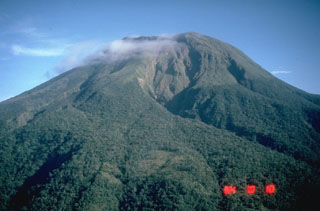Report on Bulusan (Philippines) — 23 April-29 April 2025
Smithsonian Institution / US Geological Survey
Weekly Volcanic Activity Report, 23 April-29 April 2025
Managing Editor: Sally Sennert.
Please cite this report as:
Global Volcanism Program, 2025. Report on Bulusan (Philippines) (Sennert, S, ed.). Weekly Volcanic Activity Report, 23 April-29 April 2025. Smithsonian Institution and US Geological Survey.
Bulusan
Philippines
12.769°N, 124.056°E; summit elev. 1535 m
All times are local (unless otherwise noted)
The Philippine Institute of Volcanology and Seismology (PHIVOLCS) reported increased activity at Bulusan on 27 April and a phreatic eruption on 28 April. Seismicity had increased on 12 April and continued to be elevated, prompting a special report to be issued on 21 April. On 27 April there were 53 volcanic earthquakes detected by the seismic network. Detection of strong tremor and infrasound signals started at 0354 on 28 April and lasted about 29 minutes. Local government officials reported rumbling sounds towards the end of that period in the barangays of Cogon, Bacolod, and Patag (Irosin) and in Añog and Rangas (Juban). Monitoring data indicated a phreatic eruption started about 15 minutes later, which continued during 0436-0500. A voluminous ash-and-gas plume rose 4.5 km above the crater rim and drifted generally W and SW. A small-volume pyroclastic density current descended the SW flank as far as 3 km and produced an ash cloud based on a Disaster Response Operations Monitoring and Information Center (DROMIC) report. Ashfall up to 1 mm thick was reported in Cogon, Tinampo, Omagom, Gulang-Gulang, and Bolos (Irosin), in Puting Sapa, Buraburan, and Guruyan (Juban), and in Tula-tula Sur, Caditaan, Cadandanan, Siuton, Salvacion, and Busay (Magallanes). A sulfur odor was reported in Cogon. A total of 86 volcanic earthquakes were recorded through 2000 and continuous gas emissions at the summit continued at least through 2030. The Alert Level was raised to 1 (the second lowest level on a scale of 0-5). The public was reminded not to enter the 4-km-radius Permanent Danger Zone (PDZ) and to be vigilant within the 2-km Extended Danger Zone (EDZ) on the SE flank.
A second phreatic eruption began at 1943 on 29 April and lasted about 77 minutes based on seismic and infrasound data. Weather clouds obscured views of the ash-and-gas cloud, though it likely drifted SW based on the locations of 19 communities affected by ashfall. Ashfall from trace amounts to depths around 1 cm was reported in Cogon, Tinampo, Monbon, Bolos, Gulang-Gulang, Gabao, Bulawan, and Macawayan (Irosin), in Zone 7, Somagongsong, Beguin, Aquino, San Francisco, Calomagon, Inararan, Cadandanan, Dolos, and Polot (Bulan), and in Guruyan (Juban). Rumbling was heard in Cogon and Bagsangan (Irosin). According to the Office of Civil Defense, at around 2100 there were 59 families in Cogon that evacuated to two shelters. Supplies, including hygiene kits and N95 masks, were delivered to residents and local governments were receiving support to clean up the ashfall. PHIVOLCS noted that by 2000 the seismic network had recorded a total of 54 volcanic earthquakes that day. Prior to the eruption, sulfur dioxide emissions averaged 548 tonnes per day (t/d), higher than the baseline of less than 200 t/d. The DROMIC report issued at 1800 on 30 April stated that 211 people (65 families) were in two shelters. Additionally, two people were staying with relatives or friends.
Geological Summary. Luzon's southernmost volcano, Bulusan, was constructed along the rim of the 11-km-diameter dacitic-to-rhyolitic Irosin caldera, which was formed about 36,000 years ago. It lies at the SE end of the Bicol volcanic arc occupying the peninsula of the same name that forms the elongated SE tip of Luzon. A broad, flat moat is located below the topographically prominent SW rim of Irosin caldera; the NE rim is buried by the andesitic complex. Bulusan is flanked by several other large intracaldera lava domes and cones, including the prominent Mount Jormajan lava dome on the SW flank and Sharp Peak to the NE. The summit is unvegetated and contains a 300-m-wide, 50-m-deep crater. Three small craters are located on the SE flank. Many moderate explosive eruptions have been recorded since the mid-19th century.
Sources: Philippine Institute of Volcanology and Seismology (PHIVOLCS), Office of Civil Defense, Disaster Response Operations Monitoring and Information Center (DROMIC)

